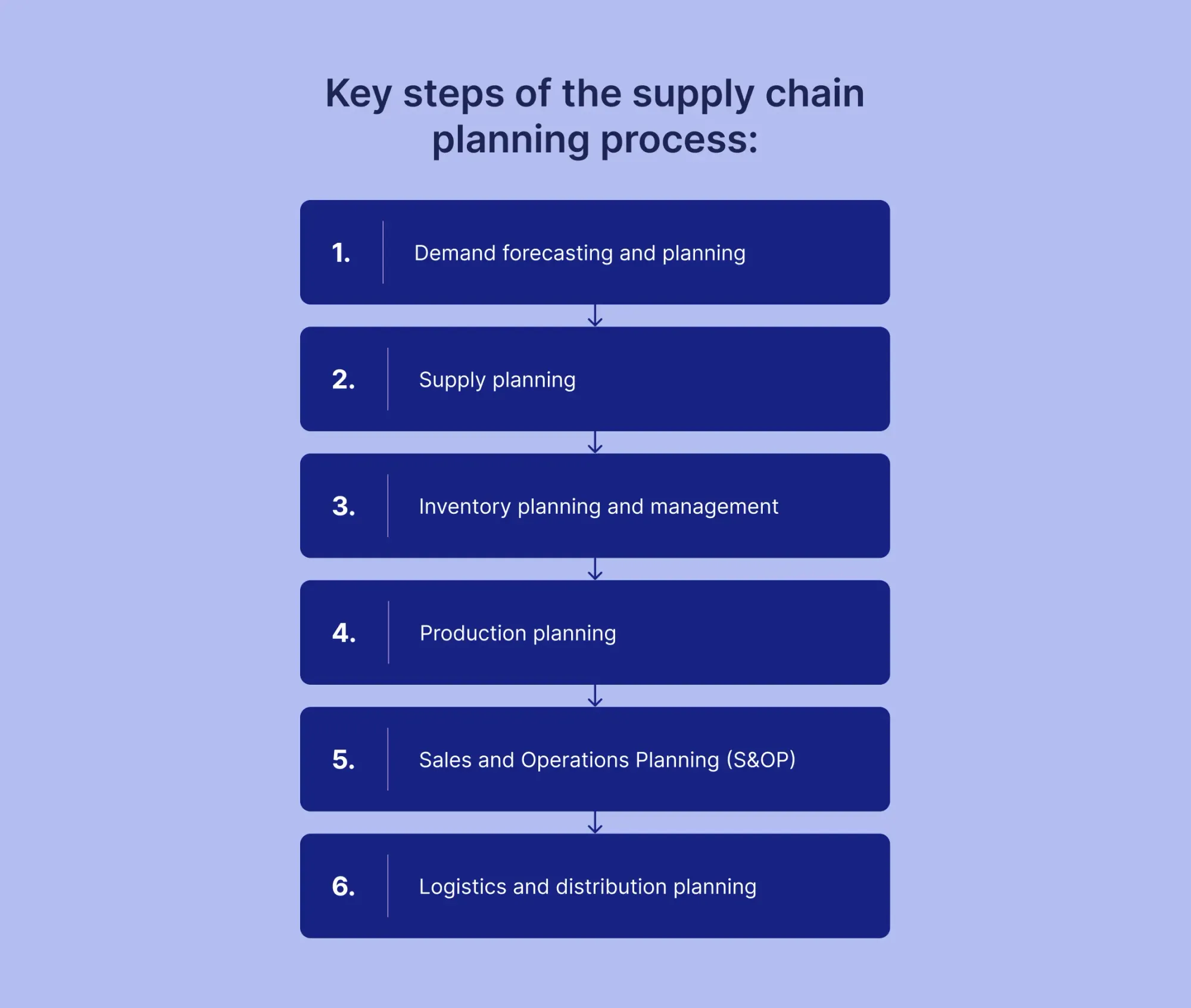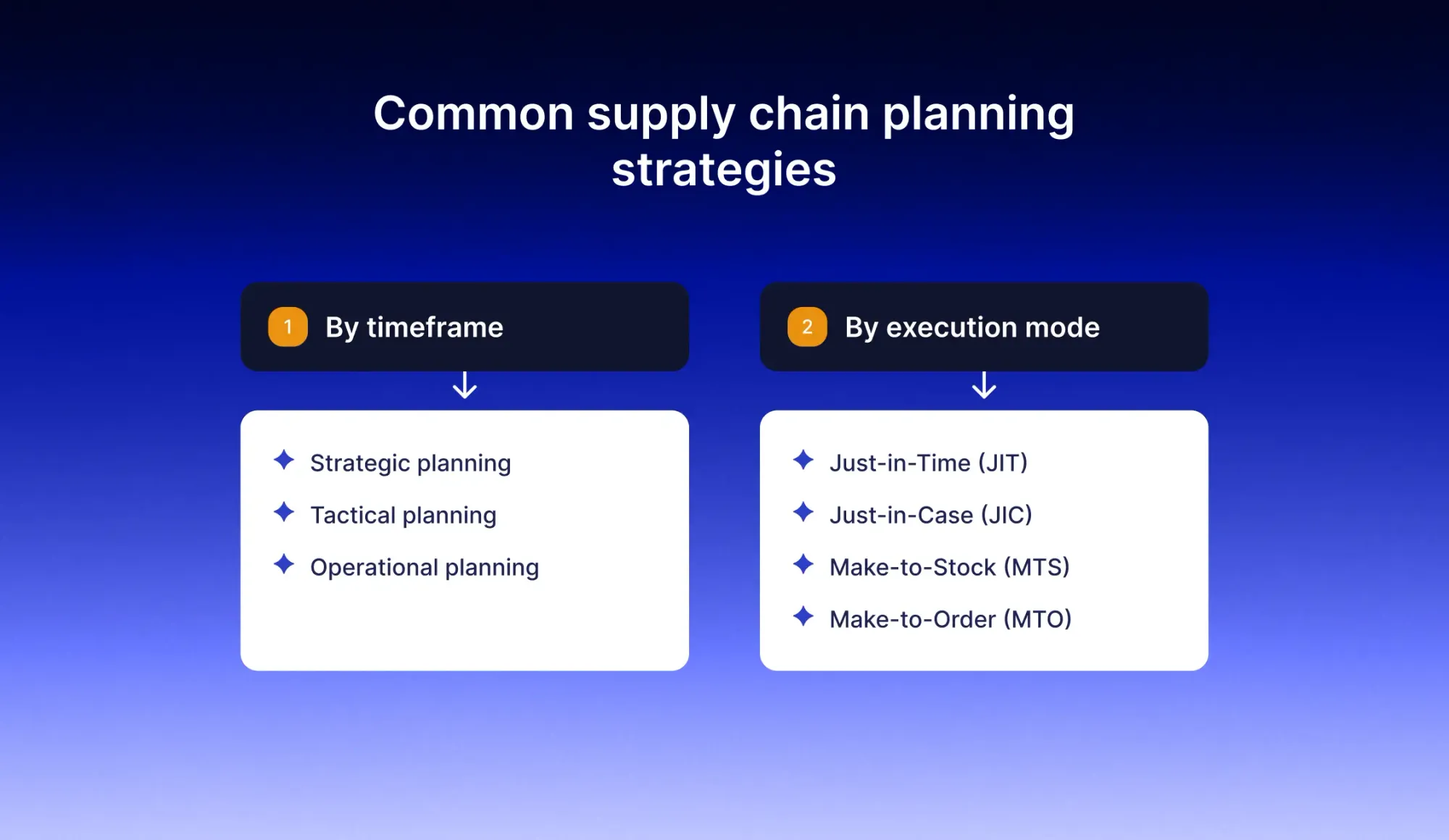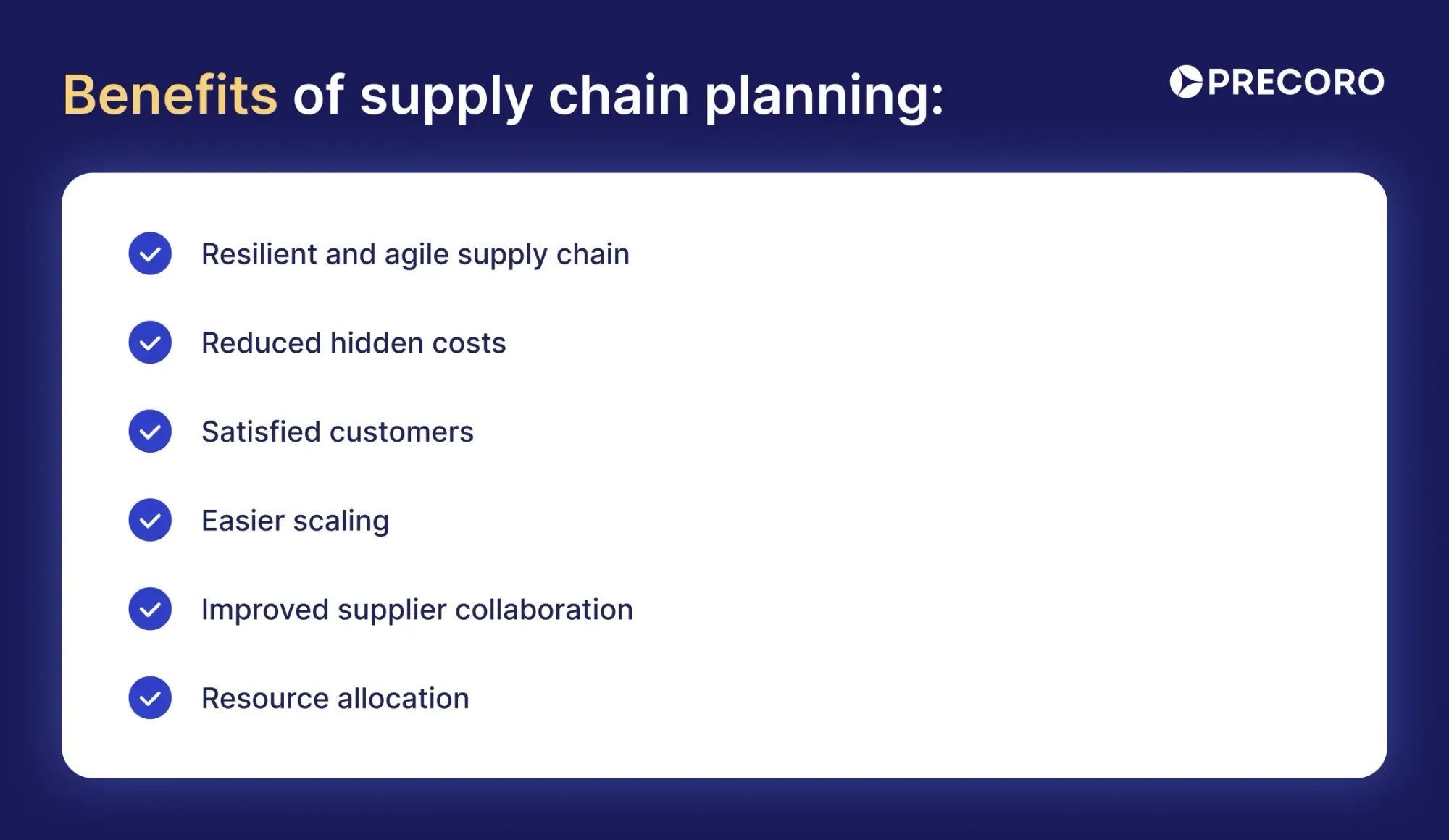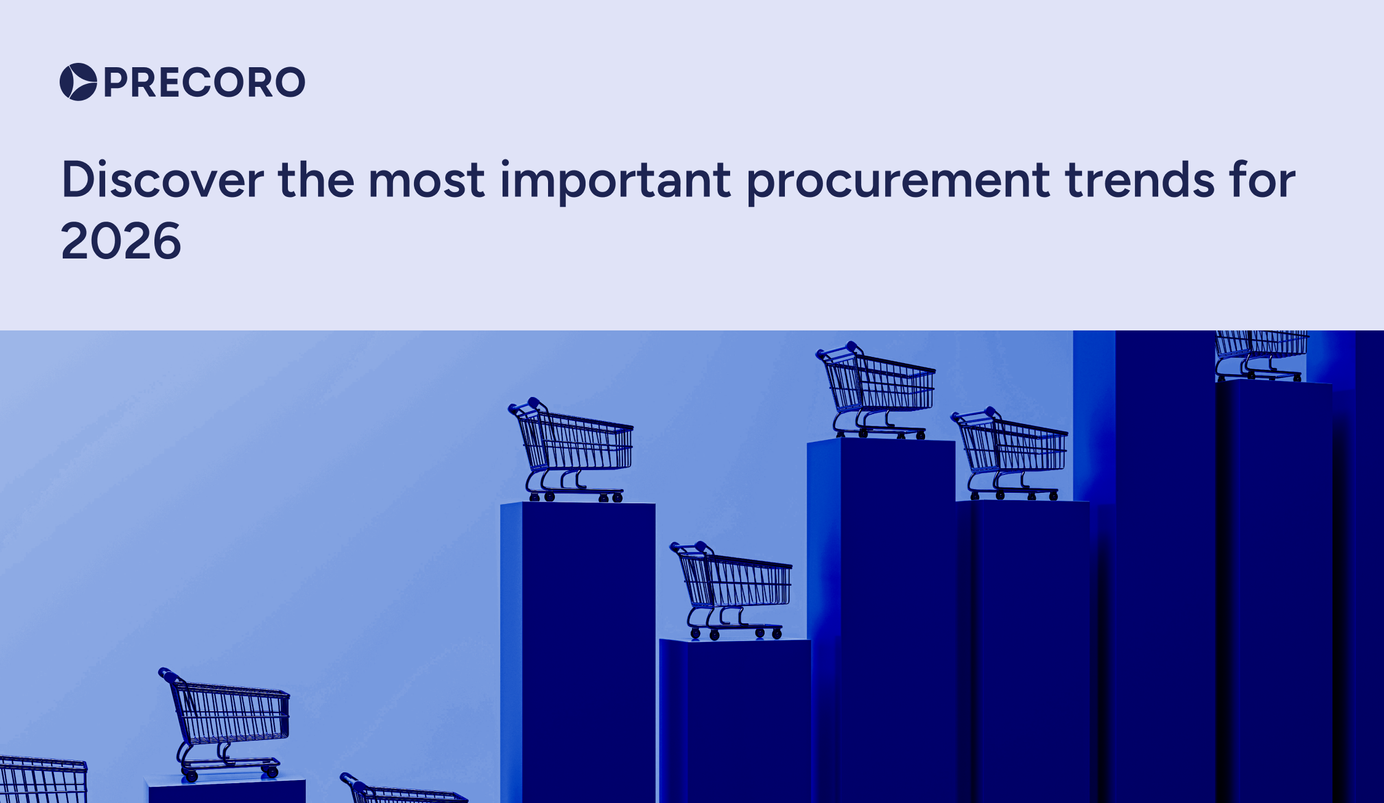
17 min read
The Practical Guide to Supply Chain Planning with Strategies and Best Practices
Get a clear view of supply chain planning. Understand its role in the SCOR model and see how to apply best practices to your operations.
The last five years alone have tested supply chains like never before. Between 2019 and 2024, nearly 93% of businesses faced disruptions from the pandemic, geopolitical tensions, natural disasters, and cyberattacks. The companies had a bitter pill to swallow: supply chains are more fragile than ever, and a standard plan that ignores potential risks no longer works.
Supply chain planning provides the structure you need in times of uncertainty. With a systematic process that leaves room for sudden spikes and changes, you can control costs ahead of time and ensure operations stay on track.
In this article, we’ll explore why having a plan is critical today, break down what the supply chain planning process is, and examine strategies for different business needs.
Keep reading to find out:
What is supply chain planning?
How does supply chain planning fit in the SCOR model?
Key steps of the supply chain planning process & best practices
Common supply chain planning strategies
Why a supply chain plan is no longer optional
Frequently asked questions about supply chain planning
How to plan and centralize your supply chain with Precoro
What is supply chain planning?
Supply chain planning is a set of steps that aims to structure the flow of goods from raw materials to final delivery. In addition to inventory preparation, it often involves forecasting customer needs and creating risk mitigation strategies. With a solid plan, you don’t have to deal with the aftermath of shortages or overstock—you can prevent these issues in the first place.
How does supply chain planning fit in the SCOR model?
A supply chain plan is the first step in the Supply Chain Operations Reference (SCOR) model, which outlines key stages needed to meet customer demand and track performance. This framework aligns the supply chain with business goals through the four Ps:
- Processes: Description of processes and how they intersect.
- People: Skills needed to manage supply chain processes.
- Practices: Standard, emerging, and best practices to improve performance.
- Performance: Supply chain metrics to track process results.
The SCOR framework breaks down the supply chain cycle into six core areas: Plan, Source, Make, Deliver, Return, and Enable. Let’s briefly examine each of these steps and what they focus on.
- Plan: This step is essentially what supply chain planning is—it sets the ground rules for everything that follows. The company decides what to produce, reviews market and customer demand, sets inventory targets, and ensures supply matches business goals. Without a clear plan, all the following steps lack direction and strategy.
- Source: Strategic sourcing secures the materials and services your products need. The procurement team selects the right suppliers, draws up contracts, and sets the best possible terms for both sides. Thorough planning helps identify which suppliers to buy from, how much to order, and when to place orders.
- Make: At this stage, materials turn into a finished product. Production scheduling, machinery maintenance, and quality control all fall under this process. If you set a clear supply chain plan, you have an outline of allocated resources, material deliveries, and volumes of produced goods to expect.
- Deliver: Once the product is out on the market, customers expect to receive it at their door or through a retailer. The delivery stage handles order management, warehousing, and transportation. Reliable supply chain planning coordinates these processes and ensures the product reaches the customer on time.
- Return: Sometimes products are subpar, and that doesn’t have to hurt customer satisfaction. This stage manages defective or excess products coming back from customers or suppliers. A good plan anticipates returns and handles them with care, while keeping costs low and customers satisfied.
- Enable: The final step of the SCOR model supports all other stages with supply chain planning tools, data, and processes. It covers performance measurement, compliance, training, and technology to keep the supply chain running effectively. Planning guides this stage and gives it the necessary structure.
Key steps of the supply chain planning process and best practices
Supply chain planning sets the rules for the steps in the SCOR model. It’s not just about matching demand with production. Six carefully defined steps, each aligned with a stage of the SCOR model, make up what the supply chain planning process is.

1. Demand forecasting and planning
Demand forecasting helps estimate future customer demand (what they’ll purchase, when, and why), so a company knows what to produce, stock, and deliver. The forecasts are usually based on data from past sales, market and competitor research, customer feedback, and seasonality patterns. The predictions from the forecasts become the foundation for demand planning.
Companies can predict what new offerings could interest customers and what changes they can make to existing products to increase their demand. This step is important: without demand forecasting, you lose money releasing products no one wants or running out of items customers are actually interested in.
Pro tip: Update forecasts with real-time insights
Demand changes fast, and forecasts can become irrelevant in just a few weeks. That’s why having a regular update schedule for each forecast is crucial. If you update predictions with real-time data from fresh reports, it’s much easier to spot potential stockouts or unused materials.
Companies use automated supply chain planning systems to speed up the process and make it less error-prone. After all, AI-driven forecasting can reduce errors by 20-50%. For instance, Precoro’s reports can show real-time spend patterns by supplier, document, or location. Data is stored in one place and updates automatically, so reports reflect what’s happening the minute you click “Run report”.
2. Supply planning
Supply planning takes the demand forecast and turns it into a concrete plan for how to meet that demand. The planners consider what they already have in inventory and what still needs to be ordered and delivered. A solid supply plan also accounts for capacity across vendors, plants, and the company itself to ensure they have enough resources to match the demand.
During supply planning, your team selects new supplies or renegotiates the terms with existing ones to cover the volume. The preferred outcome is to keep enough supplies available, minimize costs, and ensure customers get products on time.
Pro tip: Have backup suppliers
Relying on one supplier, especially for critical materials, makes your supply chain plan vulnerable. If there’s a disruption at one of the critical vendors, you risk a delay in your entire network. Geopolitical risks have made supplier diversification even more important, with 34% of companies including it in their 2025 risk mitigation strategy. The numbers speak for themselves: businesses that adopt this approach report a 30% reduction in delays.
3. Inventory planning and management
Inventory planning determines how much stock to hold, where to store it, and when to replenish. Too much inventory is essentially wasted money that could be used elsewhere, while too little leads to shortages and missed sales. A strong plan aligns stock levels with actual demand and considers metrics, defined during previous steps, such as lead times, supplier reliability, and product seasonality.
Pro tip: Keep safety stock on hand
Safety stock is extra inventory you can use to handle unexpected demand spikes or delivery delays. Keep only the minimum you need to avoid overspending. To calculate safety stock, use sales data, forecasts, and supplier performance to determine demand variability, lead time variability, and service level targets. The simplest formula you can use doesn’t account for seasonality, but it can give you a general idea of how much stock you need to keep on hand:
Safety stock = (Max. sales (demand) x Max. lead time) – (Avg. sales x Avg. lead time)
4. Production planning
Like supply planning, production planning relies on demand forecasts to create clear production schedules and allocate resources, such as equipment, human capital, and supplies, to match the demand. The role of a supply chain planner is to set timelines for each product, schedule setup and production, plan maintenance, and coordinate material arrivals. The underlying goal is to make the most out of available resources and optimize your supply chain.
Pro tip: Leave room for unexpected spikes
It’s important to maintain balance during production. While equipment shouldn’t sit unused, it also shouldn’t be stretched to its limits. Overused equipment or overworked staff can cause defective products, missed delivery deadlines, and unsafe working conditions, while underused capacity increases labor and overhead costs.
Set realistic timeframes for each production batch and factor in setup and cleanup times. Keep some capacity (materials, machinery, and staff) free to handle sudden workload during demand spikes.
5. Sales and Operations Planning (S&OP)
Sales and Operations Planning (S&OP) is a structured process that aligns sales, marketing, and financial departments with the operations team (production, inventory, supply chain management) around shared company goals.
Sales and marketing can easily overpromise to customers without knowing what’s happening in warehouses and manufacturing sites. And vice versa—without accurate demand data, production may overproduce what the market actually needs. S&OP balances priorities across the business and lets teams make decisions based on up-to-date data from every department.
Pro tip: Centralize your data in one place
Data silos and conflicting information lead to misaligned expectations. One department may demand more supplies, while another may have already ordered them. A single source of truth across the company helps keep everyone on the same page. It should cover the entire procurement process, including inventory, orders, and supplier catalogs. A centralized dashboard in supply chain planning solutions like Precoro shows all teams exactly how much the company spent, on what, and with which vendor.

6. Logistics and distribution planning
Logistics and distribution planning defines how finished goods move from production sites to customers. During this step, supply chain planners select carriers, design the most optimal routes, and look for the best warehouse locations. Additionally, they develop a delivery schedule that would both satisfy the customer and match the available resources. Fast, same-day delivery is great for customer loyalty but requires more capacity and careful planning.
Pro tip: Set up a reverse logistics workflow
Outline how returned or defective products should be transported. Assign responsibilities, set timelines for processing returns, and establish clear restocking, repair, or disposal rules. Track return volumes and costs to identify patterns or problem areas.
Common supply chain planning strategies
Supply planning isn’t one-size-fits-all. Each approach addresses a different business challenge, so understanding them helps you pick the right one for your specific goals and market conditions. You can categorize strategies by how long they take and how they’re carried out.
By timeframe
These approaches differ based on how far ahead a company needs to plan. Each timeframe serves a distinct purpose, from shaping the long-term strategy to managing daily operations:
- Strategic planning: A long-term strategy that outlines the direction the business wants to head in to align the supply chain with the company's goals. For example, it defines which market niche to tap into, which suppliers to work with for critical supplies, and where to place warehouses for the best delivery reach. A strategic supply chain plan is typically reviewed yearly.
- Tactical planning: A mid-range approach that sets production, inventory, and distribution priorities for the near future. The company sets service levels and allocates resources to meet demand for the upcoming quarter.
- Operational planning: A short-term approach that oversees the day-to-day operations of a supply chain.
By execution model
How companies plan their supply chain typically depends on the product and market demands. Some businesses manage high-volume purchases every single day and keep a large backup stock, while others produce customizable goods that take weeks to complete. Such conditions can completely change how the final product is manufactured or delivered. Let’s examine a few common strategies companies use to plan the supply chain:
- Just-in-Time (JIT): A model where goods arrive or products are made exactly when needed. Although this approach cuts inventory costs, it depends on reliable suppliers and careful planning. With JIT, there’s no safety net for demand spikes or disruptions, which led some companies to switch to the JIC model after the pandemic.
- Just-in-Case (JIC): With this strategy, companies keep extra safety stock to protect against disruptions. The downside: increased storage costs. However, if you’re in an industry that’s often exposed to supply chain risks, like biotechnology, pharmaceuticals, or consumer goods, this strategy is your best bet.
- Make-to-Stock (MTS): MTS relies entirely on forecasts—products are made ahead of time instead of on demand. Although this approach guarantees quick delivery and is perfect for industries processing many orders, any inaccurate projection can lead to overstock or stockouts. Consider using supply chain planning systems with real-time data on how much stock you currently have and how much you still need.
- Make-to-Order (MTO): The company only begins production after a customer places an order. Businesses with customizable products, such as furniture or specialty goods, plan their supply chain according to this strategy. MTO processes often involve long lead times, unpredictable demand, and extended delays when raw materials run short.

Why a supply chain plan is no longer optional
A well-structured supply chain is the backbone of a company’s success. Without it, even the best products or services can fail to reach the customer on time, at the right cost, and in the proper condition. Here are some of the benefits a supply chain plan brings to your company:
Resilient and agile supply chain
Every product you sell depends on materials, vendors, and logistics partners. A reliable supply chain ensures that your operations stay on track despite external factors. For example, 78% of companies responded to disruptions by dual-sourcing critical supplies and increasing their safety stock. If a natural disaster, a sudden spike in demand, or a delay hits, they have a set plan and resources to minimize damage.
How to achieve it: Build a diversified supplier base, maintain safety stock for critical items, and create contingency playbooks for high-risk scenarios.
Reduced hidden costs
Weak supply chain planning drives a lot of hidden costs. If shipments arrive too early, you pay for storage. If they arrive too late, you’re paying the price for missed sales or rushed deliveries. If you plan your supply chain carefully based on real-time data, you can cut these expenses ahead of time.
How to achieve it: Improve your demand forecasts so you don’t over-order, combine smaller shipments into larger ones to reduce delivery charges, and negotiate long-term deals and bulk discounts with critical suppliers.
Satisfied customers
Customers notice when shelves are empty or deliveries don’t arrive on time. Even one unsuccessful order can steer them toward competitors. Without planning ahead, you might only have a vague idea of the market demand and customer expectations for the product.
With supply chain planning, however, you can make sure there are enough products in stock when demand spikes during a holiday season. Reliable delivery outlined during planning improves satisfaction and keeps customers coming back, which is often more valuable than simple cost reduction.
How to achieve it: Base demand forecasts on real customer data from sales or market reports, track any fluctuations in delivery and customer service times, and have backup logistics partners to ensure the delivery goes through no matter what.
Easier scaling
Expanding into a new region or launching a new product is risky if your supply chain isn’t ready. Without proper preparation, suppliers or warehouses might not be able to handle the demand, or production can fail quality control checks. It’s important to draw up a detailed supply chain plan, which covers every step, from product planning to returns.
How to achieve it: Create a checklist for onboarding new suppliers, keep an updated list of approved vendors, and use centralized supply chain planning systems like Precoro, so your team can easily scale without losing track of data.
Improved supplier collaboration
Vendor relations have more impact on your company than one would expect. If a supplier delivers late, your shipments to customers are also late. But when you build strong, strategic partnerships with open communication, suppliers can help improve the final product, either by offering new materials, faster processes, or cost-effective alternatives. Structured supply chain planning gives vendors clear forecasts of what to expect and sets expectations for timelines and performance levels to achieve.
How to achieve it: Share demand forecasts on a fixed schedule, review supplier performance with vendor scorecards, and establish direct communication channels for order changes, updates, and concerns.
Resource allocation
Supply chain planning helps establish where the four Ps of the SCOR model matter most. It identifies when you need more staff or different skills, which processes require upgrades, where performance stalls, and which practices deliver the best results.
Supply planning directs resources to high-demand products, reliable suppliers, and profitable markets. Instead of spending money and time on ineffective products and practices, you use all available resources on what actually sells and supports business growth.
How to achieve it: Create forecasts that reflect real customer demand, review budgets against actual spend each month, and prioritize purchases for top-performing products and strategic suppliers.

Frequently asked questions about supply chain planning
Supply chain planning is how businesses decide what to buy and make to meet customer demand. During this process, the team forecasts demand, sets inventory levels, manages supplier capacity, and aligns logistics so products arrive where they’re needed, on time and at the right cost.
Demand forecasting is one piece of the puzzle. It predicts what customers will want and when. The supply chain planning process turns forecasts into action through supplier orders, inventory targets, production schedules, and transport bookings. Forecasting tells you what might happen, and planning tells you what to do based on these forecasts.
A supply chain planning process is the structured cycle that links demand, supply, and resources so goods move smoothly from suppliers to customers. It covers demand forecasting, supply and inventory planning, production scheduling, logistics, and sales and operations planning. Each step builds on the next and can be handled through supply chain planning tools.
Yes, arguably more than large enterprises. Smaller and mid-sized companies often don’t have big procurement teams or large extra stock. Without centralized supply chain planning tools, purchases quickly become fragmented, which, in turn, makes it harder to see where money is going or to negotiate with suppliers. Modern supply chain planning software is affordable, quick to set up, and doesn’t require heavy IT support.
It’s higher than you’d expect. Without planning, companies pay hidden costs every day in the form of missed bulk discounts and higher fees for last-minute orders. You also run into compliance risks: buying from an unsustainable or unethical supplier can result in fines or reputational damage. Lack of planning impacts the customers as well: stockouts or delays damage trust and revenue. For many mid-size companies, the “cost of doing nothing” adds up to millions in lost savings and preventable expenses each year.
Start simple: don’t try to build a perfect model overnight. The first step is to centralize all purchase requests in a supply chain planning solution to see who’s buying what, when, and at what cost. Next, map your top suppliers and most critical items. Then align procurement with finance and operations in a basic monthly review: what’s coming in, what’s running low, what’s over budget. From there, you can add demand forecasting, supplier performance tracking, and compliance checks. To quickly get visibility, invest in supply chain planning tools that centralize data and give you a clear picture of your entire supplier network.
How to plan and centralize your supply chain with Precoro
Planning a supply chain can quickly get out of hand when supplier data is scattered and maverick spend piles up. Not to mention, whether you’ll deal with overstock or stockouts heavily depends on up-to-date purchase data.
And here’s a solution: choose a reliable supply chain planning software. Precoro centralizes procurement and supplier management into one system, so you always have a clear view of who you buy from, when, and under which budget. Here’s how Precoro makes supply chain planning more reliable:
- Centralized supplier records: Every contract, catalog, and supplier transaction is visible in a single system, so you can clearly see which suppliers are worth a strategic investment. The Supplier Portal reduces back-and-forth to a minimum and lets suppliers update data, confirm POs, and upload invoices directly in the supply chain planning solution.
- Real-time budget visibility: Track spending by project or department and receive notifications when a purchase exceeds the budget. Centralized supply chain planning software lets you quickly spot redundant purchases and bulk opportunities.
- Automation capabilities: Generate POs from scratch or from existing PRs. Requisitions can be quickly filled in with previously entered information. Is AP struggling with invoices? Capture the necessary data with AI-powered OCR and create invoices with minimal manual input.
- Intake management and approvals: Guided forms capture all details upfront, and automated routing sends requests to the right approvers. Set up custom approval workflows so documents only reach the inboxes of those who actually need to sign off.
With everything centralized and automated in supply chain planning software, spend and vendor management become clear and predictable. When you have the right information, the entire process stops being reactive. You can build spend forecasts based on Precoro’s reports, see gaps in your accounts payable processes, and keep operations running without disruptions.









